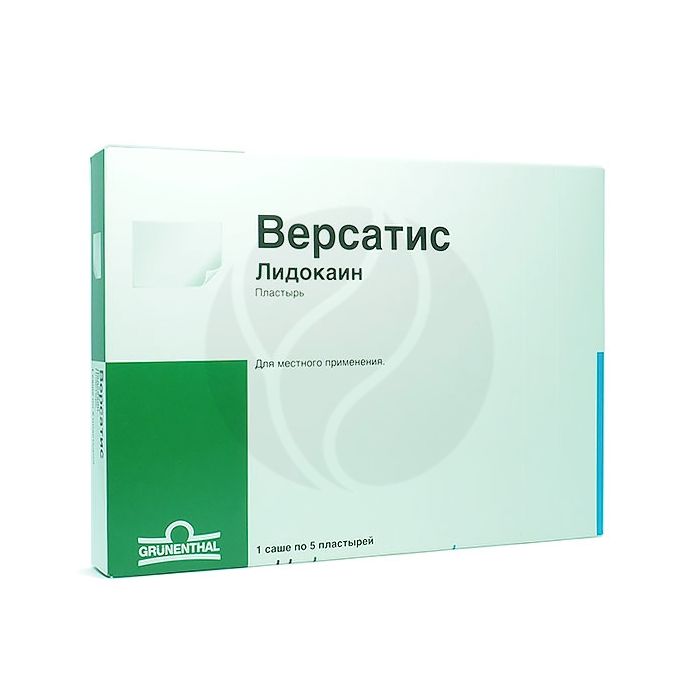Versatis plaster, 5 pcs sachet No. 1
Expiration Date: 11/2025
Russian Pharmacy name:
Версатис пластырь, 5шт саше №1
Pain syndrome with vertebral lesions;
myositis;
postherpetic neuralgia.
TTS is intended for topical use and should be adhered to the skin to cover the painful surface over the lesion. After applying the system, contact of hands with eyes should be avoided, hands should be washed immediately.
TTS can be on the skin for 12 hours. Then TTS is removed and a 12-hour break is made. Up to three TTSs can be glued at the same time.
If during the period of application of TTS there is a burning sensation or redness of the skin, it is necessary to remove the system and do not apply TTS until the redness disappears.
Used systems should be kept out of the reach of children or pets.
A plaster in the form of a polymer adhesive (sticky) material from white to light yellow, with a weak characteristic odor, evenly distributed on one side of the nonwoven material and covered with a plastic film; the inscription 'Lidocaine 5%' is engraved on the non-woven fabric; patch size: length from 13.3 to 14.7 cm, width from 9.5 to 10.5 cm.
1 plaster
lidocaine 700 mg
Excipients: purified water - 3367 mg, glycerol - 2520 mg, sorbitol - 2800 mg, polyacrylic acid solution 20% - 1400 mg, sodium polyacrylate 400-600 mPa s - 700 mg, sodium carmellose 90-168 mPa s - 700 mg, propylene glycol - 700 mg, urea - 420 mg, kaolin - 210 mg, tartaric acid (tartaric) - 210 mg, gelatin - 147 mg, polyvinyl alcohol (75,000) - 58.8 mg, aluminum dihydroxyaminoacetate (aluminum glycinate) - 32.2 mg , disodium edetate - 14 mg, methyl parahydroxybenzoate - 14 mg, propyl parahydroxybenzoate - 7 mg, nonwoven fabric - 1750 mg, plastic film (polyethylene terephthalate (PET)) - 742 mg.
Violation of the integrity of the skin at the site of TTS imposition;
hypersensitivity to lidocaine and other components of the TTS.
pharmachologic effect
Local anesthetic, acetamide derivative.
Possesses membrane stabilizing activity, causes blockade of sodium channels of excitable neuronal membranes. When applied topically, it does not irritate tissues; in recommended doses, it does not affect myocardial contractility and does not slow down AV conduction. When applied topically on intact skin, a therapeutic effect occurs, sufficient to relieve pain, without the development of a systemic effect.
Pharmacokinetics
Suction
The amount of lidocaine absorbed from the drug is 3 ± 2% of the total amount that is part of the TTS. At least 95% (665 mg) of lidocaine remains in the used TTS. When 3 TTS is applied for 12 hours, Cmax in the blood is 0.13 ?g / ml.
Distribution
Plasma protein binding - 50-80%. It is distributed quickly (T1 / 2 in the distribution phase - 6-9 minutes), first it enters well-perfused tissues, then into adipose and muscle tissues. Penetrates the BBB and the placental barrier, excreted in breast milk (up to 40% of the concentration in the mother's plasma).
Metabolism and excretion
It is metabolized in the liver (90-95%) with the participation of microsomal enzymes with the formation of pharmacologically active metabolites. It is excreted in the bile and kidneys (up to 10% - unchanged).
Side effect
Allergic reactions: allergic contact dermatitis (hyperemia at the site of application, skin rash, urticaria, itching), angioedema.
Others: burning sensation at the site of application.
Application during pregnancy and lactation
Versatis should not be used during pregnancy and lactation (breastfeeding).
Application for violations of liver function
With liver diseases, the metabolic rate decreases and ranges from 50% to 10% of the normal value.
Application for impaired renal function
In chronic renal failure, the accumulation of metabolites is possible. Acidification of urine increases the excretion of lidocaine.
special instructions
It is used with caution in infectious or traumatic skin lesions at the site of application, in acute diseases, in debilitated patients, in children under the age of 2 years and in the elderly.
Overdose
An overdose of TTS is unlikely, but it cannot be completely ruled out. improper use can result in higher plasma concentrations than normal. Possible signs of systemic toxicity in this case will be similar in nature to those after administration of lidocaine in the form of a local anesthetic.
Drug interactions
Since plasma concentrations of lidocaine are very low, clinically significant drug interactions are unlikely.
Use with caution in patients receiving class I antiarrhythmics and other local anesthetics.

